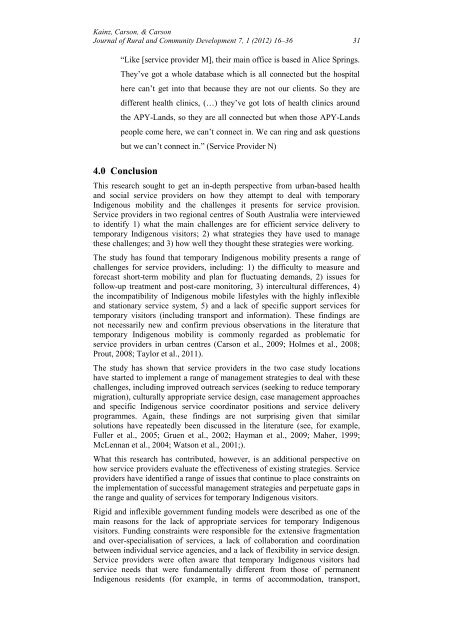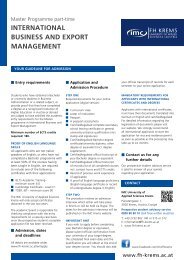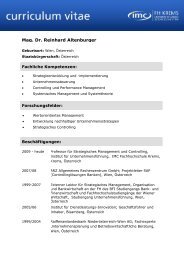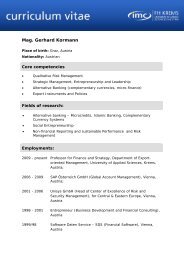Temporary Indigenous Mobility in Remote South Australia ...
Temporary Indigenous Mobility in Remote South Australia ...
Temporary Indigenous Mobility in Remote South Australia ...
Create successful ePaper yourself
Turn your PDF publications into a flip-book with our unique Google optimized e-Paper software.
Ka<strong>in</strong>z, Carson, & Carson<br />
Journal of Rural and Community Development 7, 1 (2012) 16–36 31<br />
“Like [service provider M], their ma<strong>in</strong> office is based <strong>in</strong> Alice Spr<strong>in</strong>gs.<br />
They’ve got a whole database which is all connected but the hospital<br />
here can’t get <strong>in</strong>to that because they are not our clients. So they are<br />
different health cl<strong>in</strong>ics, (…) they’ve got lots of health cl<strong>in</strong>ics around<br />
the APY-Lands, so they are all connected but when those APY-Lands<br />
people come here, we can’t connect <strong>in</strong>. We can r<strong>in</strong>g and ask questions<br />
but we can’t connect <strong>in</strong>.” (Service Provider N)<br />
4.0 Conclusion<br />
This research sought to get an <strong>in</strong>-depth perspective from urban-based health<br />
and social service providers on how they attempt to deal with temporary<br />
<strong>Indigenous</strong> mobility and the challenges it presents for service provision.<br />
Service providers <strong>in</strong> two regional centres of <strong>South</strong> <strong>Australia</strong> were <strong>in</strong>terviewed<br />
to identify 1) what the ma<strong>in</strong> challenges are for efficient service delivery to<br />
temporary <strong>Indigenous</strong> visitors; 2) what strategies they have used to manage<br />
these challenges; and 3) how well they thought these strategies were work<strong>in</strong>g.<br />
The study has found that temporary <strong>Indigenous</strong> mobility presents a range of<br />
challenges for service providers, <strong>in</strong>clud<strong>in</strong>g: 1) the difficulty to measure and<br />
forecast short-term mobility and plan for fluctuat<strong>in</strong>g demands, 2) issues for<br />
follow-up treatment and post-care monitor<strong>in</strong>g, 3) <strong>in</strong>tercultural differences, 4)<br />
the <strong>in</strong>compatibility of <strong>Indigenous</strong> mobile lifestyles with the highly <strong>in</strong>flexible<br />
and stationary service system, 5) and a lack of specific support services for<br />
temporary visitors (<strong>in</strong>clud<strong>in</strong>g transport and <strong>in</strong>formation). These f<strong>in</strong>d<strong>in</strong>gs are<br />
not necessarily new and confirm previous observations <strong>in</strong> the literature that<br />
temporary <strong>Indigenous</strong> mobility is commonly regarded as problematic for<br />
service providers <strong>in</strong> urban centres (Carson et al., 2009; Holmes et al., 2008;<br />
Prout, 2008; Taylor et al., 2011).<br />
The study has shown that service providers <strong>in</strong> the two case study locations<br />
have started to implement a range of management strategies to deal with these<br />
challenges, <strong>in</strong>clud<strong>in</strong>g improved outreach services (seek<strong>in</strong>g to reduce temporary<br />
migration), culturally appropriate service design, case management approaches<br />
and specific <strong>Indigenous</strong> service coord<strong>in</strong>ator positions and service delivery<br />
programmes. Aga<strong>in</strong>, these f<strong>in</strong>d<strong>in</strong>gs are not surpris<strong>in</strong>g given that similar<br />
solutions have repeatedly been discussed <strong>in</strong> the literature (see, for example,<br />
Fuller et al., 2005; Gruen et al., 2002; Hayman et al., 2009; Maher, 1999;<br />
McLennan et al., 2004; Watson et al., 2001;).<br />
What this research has contributed, however, is an additional perspective on<br />
how service providers evaluate the effectiveness of exist<strong>in</strong>g strategies. Service<br />
providers have identified a range of issues that cont<strong>in</strong>ue to place constra<strong>in</strong>ts on<br />
the implementation of successful management strategies and perpetuate gaps <strong>in</strong><br />
the range and quality of services for temporary <strong>Indigenous</strong> visitors.<br />
Rigid and <strong>in</strong>flexible government fund<strong>in</strong>g models were described as one of the<br />
ma<strong>in</strong> reasons for the lack of appropriate services for temporary <strong>Indigenous</strong><br />
visitors. Fund<strong>in</strong>g constra<strong>in</strong>ts were responsible for the extensive fragmentation<br />
and over-specialisation of services, a lack of collaboration and coord<strong>in</strong>ation<br />
between <strong>in</strong>dividual service agencies, and a lack of flexibility <strong>in</strong> service design.<br />
Service providers were often aware that temporary <strong>Indigenous</strong> visitors had<br />
service needs that were fundamentally different from those of permanent<br />
<strong>Indigenous</strong> residents (for example, <strong>in</strong> terms of accommodation, transport,
















